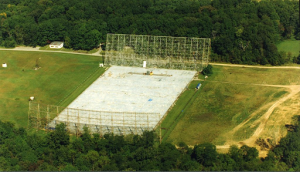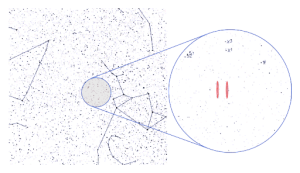Mysteries, Oddities, and Everything Strange: Wow! Signal
February 3, 2023
Wow! Signal: The Potential for Quintessential Extra Terrestrials
Alien life has long been one of humanity’s most fervent curiosities. The universe is unimaginably massive, spanning billions of light years. A star 65 million light years away would still be able to glimpse the dinosaurs, so billions of light years away would catch a peak at the beginning of life as we know it. Regardless, with the massive scale of all that we know, there has to be some other life form out there…right? With the sheer size and scale of the universe, the people on Earth cannot be the only advanced civilizations in the universe. Well, humanity might have already made contact with life forms outside of our own planet in the year 1977 through a phenomenon affectionately known as the “Wow!” signal.
 On the night of August 15, 1977, the town of Delaware, Ohio was home to the Big Ear Radio Telescope, a powerful tool utilized to scan the galaxy for signs of life. Star Wars: A New Hope had been released less than three months earlier and the world’s obsession with space exploration was at an all-time high. After a night of mundane searching, the telescope picked up a signal more powerful than anything it had ever seen before. A 72 second broadcast occurred on this night, which was recorded and reviewed later by Jerry Ehman. The astronomer was so appalled by the discovery that he scrawled one word in red pen onto the data sheet: “Wow!”
On the night of August 15, 1977, the town of Delaware, Ohio was home to the Big Ear Radio Telescope, a powerful tool utilized to scan the galaxy for signs of life. Star Wars: A New Hope had been released less than three months earlier and the world’s obsession with space exploration was at an all-time high. After a night of mundane searching, the telescope picked up a signal more powerful than anything it had ever seen before. A 72 second broadcast occurred on this night, which was recorded and reviewed later by Jerry Ehman. The astronomer was so appalled by the discovery that he scrawled one word in red pen onto the data sheet: “Wow!”
The Big Ear Radio Telescope was a famous telescope among professional space enthusiasts and astronomers, designed by John Kraus from Ohio State University. It was built in the 1960s with the help of volunteers and funds from the National Science Foundation. This telescope was revolutionary and had a large reflective surface the size of a football field to collect data from outer space. Its first job was to map the radio sky, but it finished this task quickly and moved on to alien investigation with the help of NASA, lawyers, doctors, college professors, and other people passionate about the discovery of extraterrestrials.
Jerry Ehman was one of these volunteers, tasked with clearing the computer’s memory and resetting it every couple of weeks to make sure it could continue collecting data. The signal read 6EQUJ5, which in the language of astronomy means the signal had started out weak, climbed in strength, and dropped off after its peak. Ehman continued investigating the source of this broadcast but found nothing. Determined, he explored the same patch of sky the signal originated from for a month, but no results were collected. He recruited the help of other people at the observatory and attempted the project again 1 year after the incident with no success.
The telescope was deemed unworthy of public funding in 1993 and destroyed in 1998, ending a 24-year-long career of alien hunting. Despite its demolition, the telescope inspired large groups of alien hunters to continue their mission by searching in space for high-energy blasts. Emails are still sent to astronomers working at the observatory about potential theories and codes that could have arisen from the message, but a first message between different forms of life should probably be more legible.
 This event wowed the public (pun intended) beyond belief. For the first time, there was potential definitive proof of life outside of our own existence in the universe. Scientifically, though, the “Wow!” signal is much more insignificant than the public would like to believe. The running theory is that the energy spike was generated by two comets passing through the area: 226P/Christensen and P/2008 Y2 (Gibbs). The powerful signal likely came from the hydrogen cloud that either comet could have produced upon its journey. A team led by astronomer Antonia Paris traveled out to the former site and measured the energy produced when the two comets passed through the sky again, and it matched the energy signatures of the “Wow!” signal. The energy picked up by the comet was much weaker than the telescope’s initial reading, but that was due to the smaller size of the telescope utilized.
This event wowed the public (pun intended) beyond belief. For the first time, there was potential definitive proof of life outside of our own existence in the universe. Scientifically, though, the “Wow!” signal is much more insignificant than the public would like to believe. The running theory is that the energy spike was generated by two comets passing through the area: 226P/Christensen and P/2008 Y2 (Gibbs). The powerful signal likely came from the hydrogen cloud that either comet could have produced upon its journey. A team led by astronomer Antonia Paris traveled out to the former site and measured the energy produced when the two comets passed through the sky again, and it matched the energy signatures of the “Wow!” signal. The energy picked up by the comet was much weaker than the telescope’s initial reading, but that was due to the smaller size of the telescope utilized.
Unfortunately, the “Wow!” signal was likely not the first contact humans had with extraterrestrial life. Still, humanity will continue to make hit blockbuster movies about the possible doomsday waiting for us when they do (my personal favorite is Pixels). Regardless, astronomy has grown exponentially in the past few decades, and our first contact with alien life might arrive sooner than we think, as we are closer to the far reaches of space than ever before.
Resources:
https://en.wikipedia.org/wiki/Wow!_signal
https://earthsky.org/space/wow-signal-explained-comets-antonio-paris/
https://astronomy.com/news/2020/09/the-wow-signal-an-alien-missed-connection














































